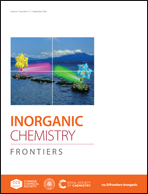Ferroelectric polyoxometalate-modified nano semiconductor TiO2 for increasing electron lifetime and inhibiting electron recombination in dye-sensitized solar cells†
Abstract
Electron–hole recombination in dye-sensitized solar cells (DSSCs) limits further improvements in the efficiency of the cells. Finding suitable materials to modify the TiO2 semiconductor layer can effectively reduce electron recombination. Ferroelectric compounds are important materials with excellent ferroelectric and dielectric properties. One of the characteristics of this kind of material is that their positive and negative charges do not coincide in the lattice structure, thus it will form a spontaneous polarization field. The inherent electric field can effectively separate photogenerated electrons and holes, therefore, the introduction of ferroelectric materials into DSSCs may effectively improve the photoelectric conversion efficiency of the cells. We used a sandwich-type ferroelectric polyoxometalate KNa3[HPro]7[Sm(α-PW11O39)2]·Pro·18H2O (Sm) (Pro = D-proline) to modify the photoanode of DSSCs for the first time. The results show that photogenerated electrons can transfer from the conduction band of TiO2 to the LUMO energy level of Sm and then to the external circuit. Electrochemical tests show that when Sm is combined with TiO2 to modify the photoanode of DSSCs, the Jsc and PCE reached 15.13 mA cm−2 and 6.82%, respectively. The PCE is 21.8% higher than that of pure TiO2. As a result, ferroelectric polyoxometalate Sm is a good electron transfer medium that can reduce electron–hole recombination and increase the electron lifetime. The incorporation of functional ferroelectric materials into solar cells is a promising strategy to improve photovoltaic devices.



 Please wait while we load your content...
Please wait while we load your content...